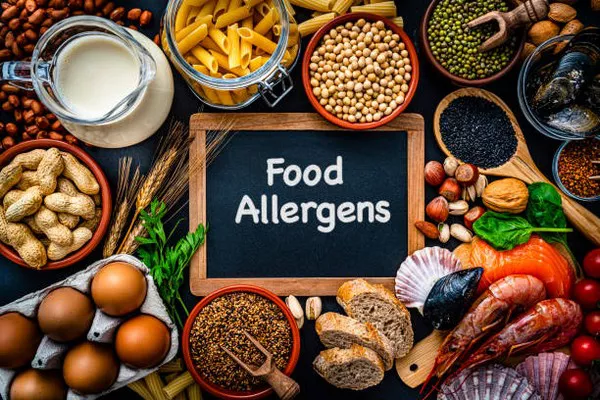Soy, a versatile legume, is a common ingredient in many food products. While it serves as a valuable source of protein for some, others may find themselves grappling with soy allergies. This article delves into the intricacies of soy allergies, exploring the symptoms that manifest in both babies and adults. Recognizing these symptoms is crucial for prompt diagnosis and effective management of soy allergies.
Soy Allergy
Soy allergy is an immune system response triggered by proteins found in soybeans. The body perceives these proteins as harmful invaders and initiates an immune response, leading to various symptoms. Soy allergies are relatively common, particularly in infants and young children. It’s essential to differentiate between soy allergies and other adverse reactions to soy, such as soy intolerance.
See Also: Soy Allergy: Causes, Symptoms, & Management
Soy Allergy vs. Soy Intolerance
Soy Allergy:
Involves the immune system.
Results from an allergic reaction to soy proteins.
Can lead to symptoms ranging from mild to severe.
Soy Intolerance:
Does not involve the immune system.
Arises from difficulty digesting soy.
Symptoms are generally less severe and may include digestive issues.
Soy Allergy Triggers
Soy allergies can be triggered by various soy-based products, including soy milk, tofu, soy sauce, edamame, and soybean oil. Additionally, soy proteins can be present in processed foods, making it essential to carefully read food labels.
See Also: 15 Foods to Avoid If You Have a Soy Allergy
Soy Allergy Symptoms in Babies
Babies can develop soy allergies, often in conjunction with other food allergies. Recognizing the symptoms is crucial for early intervention. Common soy allergy symptoms in babies include:
Skin Reactions:
Hives
Eczema
Itchy skin
Gastrointestinal Symptoms:
Vomiting
Diarrhea
Abdominal pain
Respiratory Issues:
Sneezing
Runny or stuffy nose
Wheezing
Severe Reactions:
Anaphylaxis (rare but potentially life-threatening)
Difficulty breathing
Swelling of the face and lips
Soy Allergy Symptoms in Adults
While soy allergies often emerge in childhood, they can also develop in adulthood. Adults with soy allergies may experience a range of symptoms, including:
Digestive Symptoms:
Nausea
Diarrhea
Abdominal pain or cramps
Skin Reactions:
Hives
Itchy skin
Eczema
Respiratory Issues:
Runny or stuffy nose
Sneezing
Shortness of breath or wheezing
Severe soy allergies can lead to anaphylaxis, characterized by a sudden drop in blood pressure, difficulty breathing, and loss of consciousness. This is a medical emergency requiring immediate intervention.
Diagnosis of Soy Allergies
If soy allergy is suspected, seeking a proper diagnosis is crucial for effective management. The following diagnostic methods are commonly employed:
Medical History:
Detailed discussions about symptoms and potential soy exposure.
Skin Prick Test:
Small amounts of soy protein are applied to the skin with a tiny needle. Any resulting skin reactions indicate a potential soy allergy.
Blood Test:
Measures the presence of specific antibodies (IgE) that the body produces in response to soy proteins.
Oral Food Challenge:
Under medical supervision, the individual consumes increasing amounts of soy to observe any allergic reactions.
Managing Soy Allergies
Once diagnosed, managing soy allergies involves strict avoidance of soy-containing products. Tips for managing soy allergies include:
Reading Food Labels:
Thoroughly check ingredient lists for soy-based products.
Be aware of hidden sources of soy, such as lecithin, tofu, and textured vegetable protein.
Educating Others:
Inform family, friends, caregivers, and teachers about the soy allergy.
Emphasize the importance of avoiding cross-contamination during food preparation.
Alternative Protein Sources:
Explore alternative protein sources, such as meat, poultry, fish, dairy, and legumes (excluding soy).
Medical Alert Devices:
Wear a medical alert bracelet or necklace indicating the soy allergy, especially in severe cases.
Soy Allergy and Cross-Reactivity
Individuals with soy allergies may experience cross-reactivity with other legumes, such as peanuts and other beans. This means that they may also be allergic to proteins found in these related foods. It is essential to be aware of potential cross-reactivity and consult with a healthcare professional for guidance.
Conclusion
Soy allergies, whether in babies or adults, necessitate vigilance, awareness, and proactive management. Understanding the symptoms, obtaining a proper diagnosis, and implementing effective strategies for avoidance are paramount. As research continues to shed light on allergies and intolerances, individuals with soy allergies can look forward to improved awareness, support, and alternative food options. With diligence and proper management, those with soy allergies can lead healthy and fulfilling lives.

